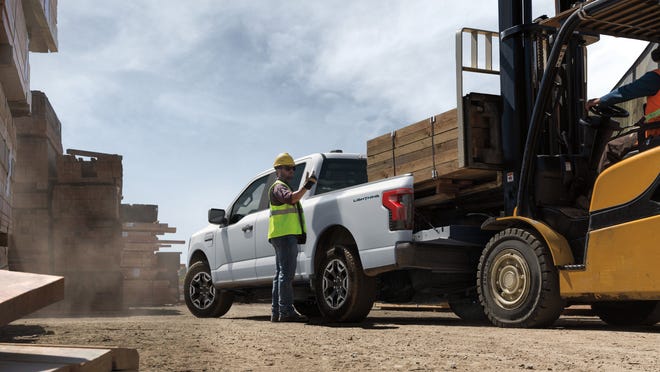Ford revealed details of a less powerful version of its upcoming 2022 F-150 Lightning electric pickup for business and government fleets on Monday. Called the Lightning Pro, it’s equipped with a standard battery that’s good for an estimated 230 miles and costs $39,974, the same as the base price for retail F-150 Lightnings.
The base Lightning Pro’s two electric motors — one for each axle — are expected to generate 426 horsepower and 775 pound-feet of torque. The base model will be able to tow up to 5,000 pounds and carry a payload up to 2,000.

An optional bigger battery will give Lightning Pro a 300-mile range, 563 hp and the ability to tow 10,000 pounds. Prices for that model start at $49,974. All Lightning Pros have full-time four-wheel drive.
Fleet buyers, which include construction and landscaping companies, utilities and all levels of government, “focus on the cost and capability to complete the job. No more, no less,” said Ted Cannis, general manager of Ford’s North American commercial business.
Fleets tend to be consistent, long-term customers. They’re a large and profitable part of Ford’s business with the conventionally powered F-series pickup, which has been America’s bestselling vehicle for 44 years
They’re also key to the automaker’s shift to electric power, which also includes an electric version of its large Transit delivery van. Ford expects U.S. sales of electric pickups and vans to reach 1 million a year by 2030.
More:GM invests in Pontiac Stamping to support EV production, creates new job positions
More:2022 Ford F-150 Lightning electric pickup revealed
“Fleets are ideal for EVs,” Autotrader executive analyst Michelle Krebs said. “Fleets have scheduled, predictable work patterns, which makes the charging more predictable and easily scheduled for non-peak times.”
Autotrader’s research shows nearly 40% of buyers shopping for a pickup would consider electric power and that younger buyers are particularly interested in making the change from internal combustion engines, also called ICE.
The Lightning goes on sale in spring 2022.
‘Show me the money’
“Work vehicles present a growing opportunity for electrification,” said Steve Carey, president and CEO of NTEA, the work-truck industry association.
“As electrified vehicles continue to evolve and availability expands, we anticipate an increased adoption rate in commercial applications. Proper training for fleets to determine suitable applications — both from a total cost of ownership, and drive and duty cycle perspective — will be extremely important. Effective and efficient charging solutions for fleet requirements and quality of guidance provided to equipment installers will also be vital to implementation in commercial applications.”
Fleet customers will save money with the Lightning Pro from day one, due to the lower cost of gasoline and less maintenance and repairs for EVs, Cannis said.
That would eliminate a major obstacle to fleets’ adoption of EVs. There’s a widespread perception they cost more than ICE vehicles. Another hurdle will be operating range, but Ford’s research shows that the average F-150 owners travel less than 174 miles 95% of the time, putting them well within the base F-150 Lightning’s operating envelope. Because EVs have fewer moving parts and mechanically simpler drivetrains, Ford claims a Lightning Pro’s scheduled maintenance costs will be 40% lower than an ICE F-150 over eight years and 100,000 miles.
Fleet customers are skeptical and data-driven. Unlike retail customers, who prioritize upfront purchase cost, they weigh every element of ownership.
“Purchase price is important, but fuel and maintenance costs hold equal weight in the overall assessment. In other words, fleets look to evaluate the value of acquiring a vehicle — whether it is an ICE or a BEV — by the life cycle cost, the total cost of ownership,” said Erica Schueller, editorial director for FleetOwner and the Endeavor Commercial Vehicle Group.
“I don’t foresee an immediate shift to full electric until operational data can provide direct evidence to prove the value. Many will likely take a wait-and-see approach, or test a couple of vehicles in their fleet to understand performance and expectations.”
New features
Ford hopes new features will help close the sale.
Up front, where the engine used to go, a 14.1-cubic-foot storage space includes power outlets, USB ports, cargo lights and pop can-sized under-floor storage with a drain plug.
The tailgate includes worker’s helpers including a step for access to the bed; cup, pencil and phone holders; slots for clamps and a ruler to measure cuts. Mounting points in the bed are identical to current F-150s, so toolboxes and racks remain usable.
More outlets allow the Pro to provide 99.6 kilowatts of power to run a work site. The driver can program an alert to make sure power tools don’t leave the pickup without enough juice to make it home.
The onboard computer calculates range and recommends nearby public chargers, but Ford expects most charging to be done overnight, either at drivers’ homes or a central depot. The truck verifies home charging for driver reimbursement.
Ford says the 230-mile battery can be fully charged in 10 hours at 240 volts, while the 300-mile battery gets a full charge in eight hours at 240 volts with Ford’s fastest 80-amp charging station. Fast charging at 150kW DC chargers can take the charge from 15% to 80% in 44 minutes for the 230-mile battery and 41 minutes for extended range.
Ford will offer telematics services including geofencing, tracking and service alerts. Over-the-air updates will add features over time as Ford works to ensure it’s a leader in commercial electric vehicles, similar to the 43% share of class 1-7 vehicles it claims today.
“In the U.S., we expect one-third of the full-size pickup segment to go fully electric by 2030, representing more than 800,000 vehicles annually,” Cannis said. “Plus, we see 70% of the full-size bus and van industry going electric by 2030. That’s more than 300,000 vehicles annually.”